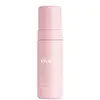What's inside
What's inside
 Key Ingredients
Key Ingredients

 Benefits
Benefits

 Concerns
Concerns

 Ingredients Side-by-side
Ingredients Side-by-side

Water
Skin ConditioningPotassium Cocoyl Glycinate
Cocamidopropyl Betaine
CleansingPotassium Cocoate
EmulsifyingGlycerin
HumectantHydroxyacetophenone
Antioxidant1,2-Hexanediol
Skin ConditioningCaprylyl Glycol
EmollientTrisodium Ethylenediamine Disuccinate
Citric Acid
BufferingPolyquaternium-39
Parfum
MaskingSodium Benzoate
MaskingActinidia Chinensis Seed Oil
EmollientSodium Hyaluronate
HumectantPhenoxyethanol
PreservativeWater, Potassium Cocoyl Glycinate, Cocamidopropyl Betaine, Potassium Cocoate, Glycerin, Hydroxyacetophenone, 1,2-Hexanediol, Caprylyl Glycol, Trisodium Ethylenediamine Disuccinate, Citric Acid, Polyquaternium-39, Parfum, Sodium Benzoate, Actinidia Chinensis Seed Oil, Sodium Hyaluronate, Phenoxyethanol
Water
Skin ConditioningGlycerin
HumectantPotassium Cocoyl Glycinate
Lauramidopropyl Betaine
CleansingHydroxypropyl Starch Phosphate
Acrylates Copolymer
Artemisia Capillaris Extract
Camellia Sinensis Leaf Extract
AntimicrobialCamellia Sinensis Leaf Powder
ExfoliatingApium Graveolens Stem Extract
HumectantCoptis Japonica Extract
AntimicrobialArtemisia Montana Leaf Powder
ExfoliatingBrassica Oleracea Acephala Leaf Extract
HumectantCichorium Intybus Leaf Extract
MaskingBrassica Oleracea Italica Extract
AstringentCitric Acid
BufferingPotassium Cocoate
EmulsifyingSodium Chloride
MaskingHydroxyacetophenone
AntioxidantDipropylene Glycol
HumectantCaprylyl Glycol
EmollientButylene Glycol
HumectantGardenia Florida Fruit Extract
Skin ConditioningMaltodextrin
AbsorbentDipotassium Glycyrrhizate
Humectant1,2-Hexanediol
Skin ConditioningWater, Glycerin, Potassium Cocoyl Glycinate, Lauramidopropyl Betaine, Hydroxypropyl Starch Phosphate, Acrylates Copolymer, Artemisia Capillaris Extract, Camellia Sinensis Leaf Extract, Camellia Sinensis Leaf Powder, Apium Graveolens Stem Extract, Coptis Japonica Extract, Artemisia Montana Leaf Powder, Brassica Oleracea Acephala Leaf Extract, Cichorium Intybus Leaf Extract, Brassica Oleracea Italica Extract, Citric Acid, Potassium Cocoate, Sodium Chloride, Hydroxyacetophenone, Dipropylene Glycol, Caprylyl Glycol, Butylene Glycol, Gardenia Florida Fruit Extract, Maltodextrin, Dipotassium Glycyrrhizate, 1,2-Hexanediol
 Reviews
Reviews

Ingredients Explained
These ingredients are found in both products.
Ingredients higher up in an ingredient list are typically present in a larger amount.
1,2-Hexanediol is a synthetic liquid and another multi-functional powerhouse.
It is a:
- Humectant, drawing moisture into the skin
- Emollient, helping to soften skin
- Solvent, dispersing and stabilizing formulas
- Preservative booster, enhancing the antimicrobial activity of other preservatives
Caprylyl Glycol is a humectant and emollient, meaning it attracts and preserves moisture.
It is a common ingredient in many products, especially those designed to hydrate skin. The primary benefits are retaining moisture, skin softening, and promoting a healthy skin barrier.
Though Caprylyl Glycol is an alcohol derived from fatty acids, it is not the kind that can dry out skin.
This ingredient is also used as a preservative to extend the life of products. It has slight antimicrobial properties.
Learn more about Caprylyl GlycolCitric Acid is an alpha hydroxy acid (AHA) naturally found in citrus fruits like oranges, lemons, and limes.
Like other AHAs, citric acid can exfoliate skin by breaking down the bonds that hold dead skin cells together. This helps reveal smoother and brighter skin underneath.
However, this exfoliating effect only happens at high concentrations (20%) which can be hard to find in cosmetic products.
Due to this, citric acid is usually included in small amounts as a pH adjuster. This helps keep products slightly more acidic and compatible with skin's natural pH.
In skincare formulas, citric acid can:
While it can provide some skin benefits, research shows lactic acid and glycolic acid are generally more effective and less irritating exfoliants.
Most citric acid used in skincare today is made by fermenting sugars (usually from molasses). This synthetic version is identical to the natural citrus form but easier to stabilize and use in formulations.
Read more about some other popular AHA's here:
Learn more about Citric AcidGlycerin is already naturally found in your skin. It helps moisturize and protect your skin.
A study from 2016 found glycerin to be more effective as a humectant than AHAs and hyaluronic acid.
As a humectant, it helps the skin stay hydrated by pulling moisture to your skin. The low molecular weight of glycerin allows it to pull moisture into the deeper layers of your skin.
Hydrated skin improves your skin barrier; Your skin barrier helps protect against irritants and bacteria.
Glycerin has also been found to have antimicrobial and antiviral properties. Due to these properties, glycerin is often used in wound and burn treatments.
In cosmetics, glycerin is usually derived from plants such as soybean or palm. However, it can also be sourced from animals, such as tallow or animal fat.
This ingredient is organic, colorless, odorless, and non-toxic.
Glycerin is the name for this ingredient in American English. British English uses Glycerol/Glycerine.
Learn more about GlycerinHydroxyacetophenone is antioxidant with skin conditioning and soothing properties. It also boosts the efficiency of preservatives.
This ingredient is not irritating or sensitizing.
This ingredient is the potassium salt of coconut acid. Coconut acid is created by mixing fatty acids from coconut oil.
It is an emulsifier, surfactant, and cleanser. According to a manufacturer, it contains glycerin.
Potassium Cocoyl Glycinate is an amino acid-based surfactant and cleaning agent. This ingredient can be derived from animals or plants. It may also be synthetically created from fatty acids of the coconut and glycine.
Potassium Cocoyl Glycinate is a gentle surfactant. Surfactants help gather the dirt, oil, and other pollutants from your skin to be rinsed away. It is a mild cleanser and naturally produces foam.
Water. It's the most common cosmetic ingredient of all. You'll usually see it at the top of ingredient lists, meaning that it makes up the largest part of the product.
So why is it so popular? Water most often acts as a solvent - this means that it helps dissolve other ingredients into the formulation.
You'll also recognize water as that liquid we all need to stay alive. If you see this, drink a glass of water. Stay hydrated!
Learn more about Water